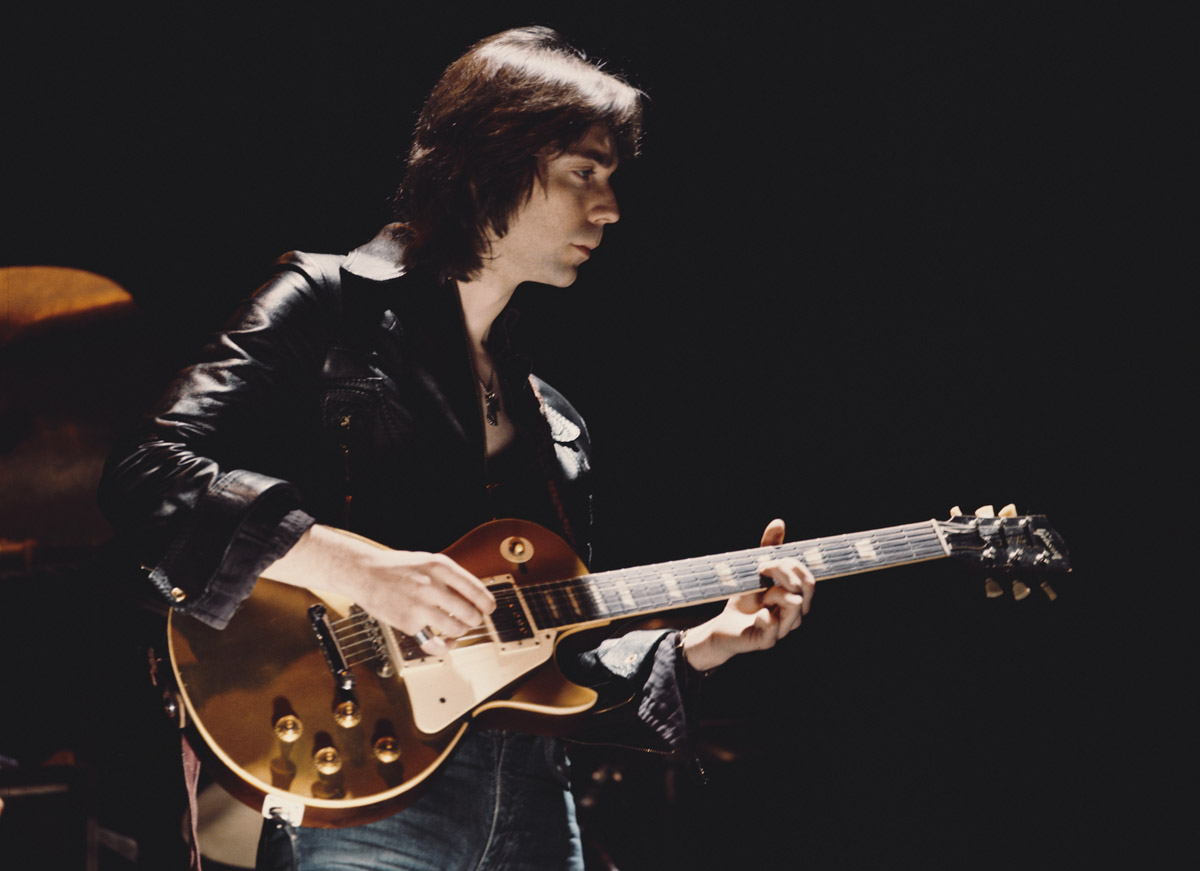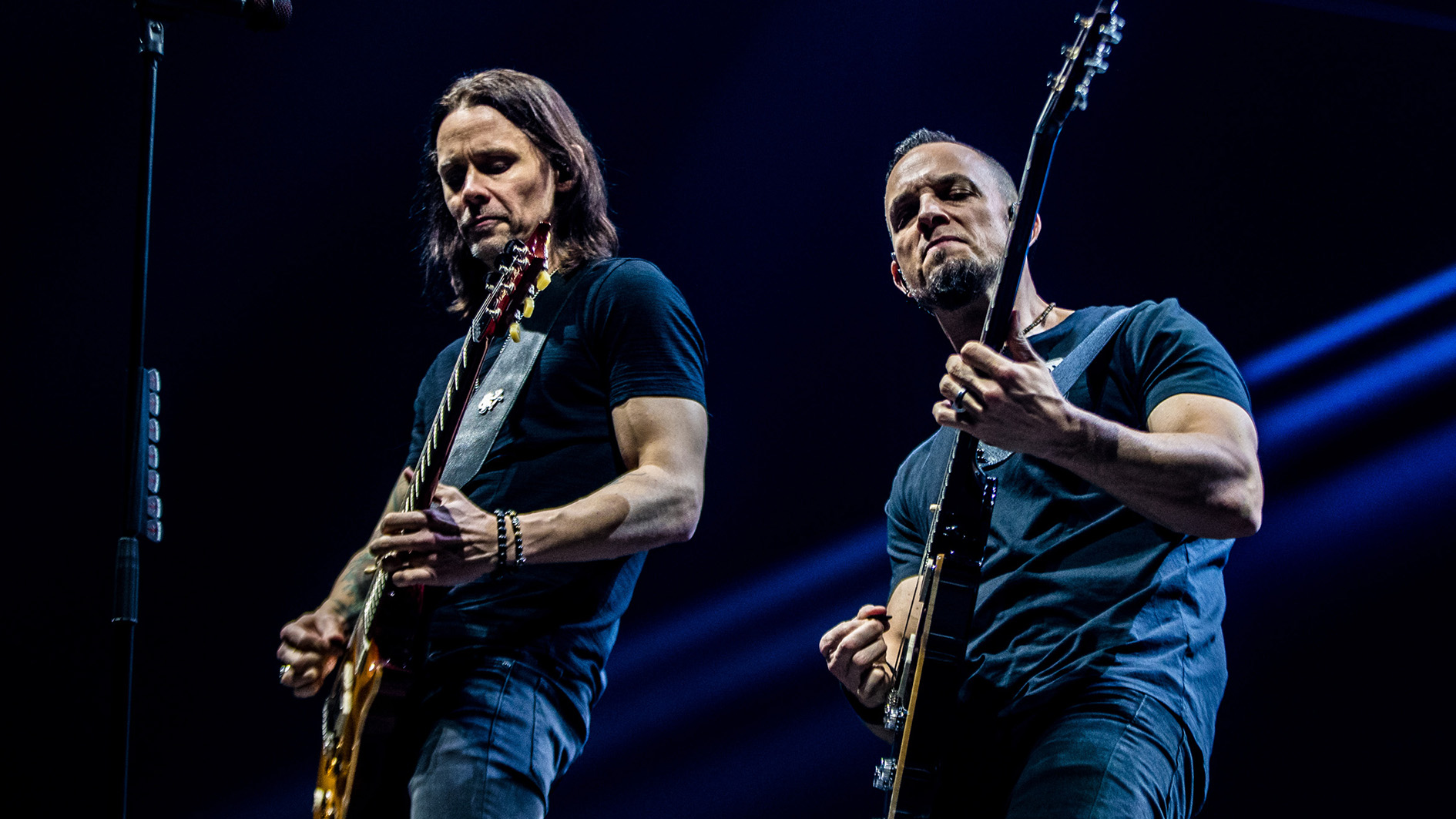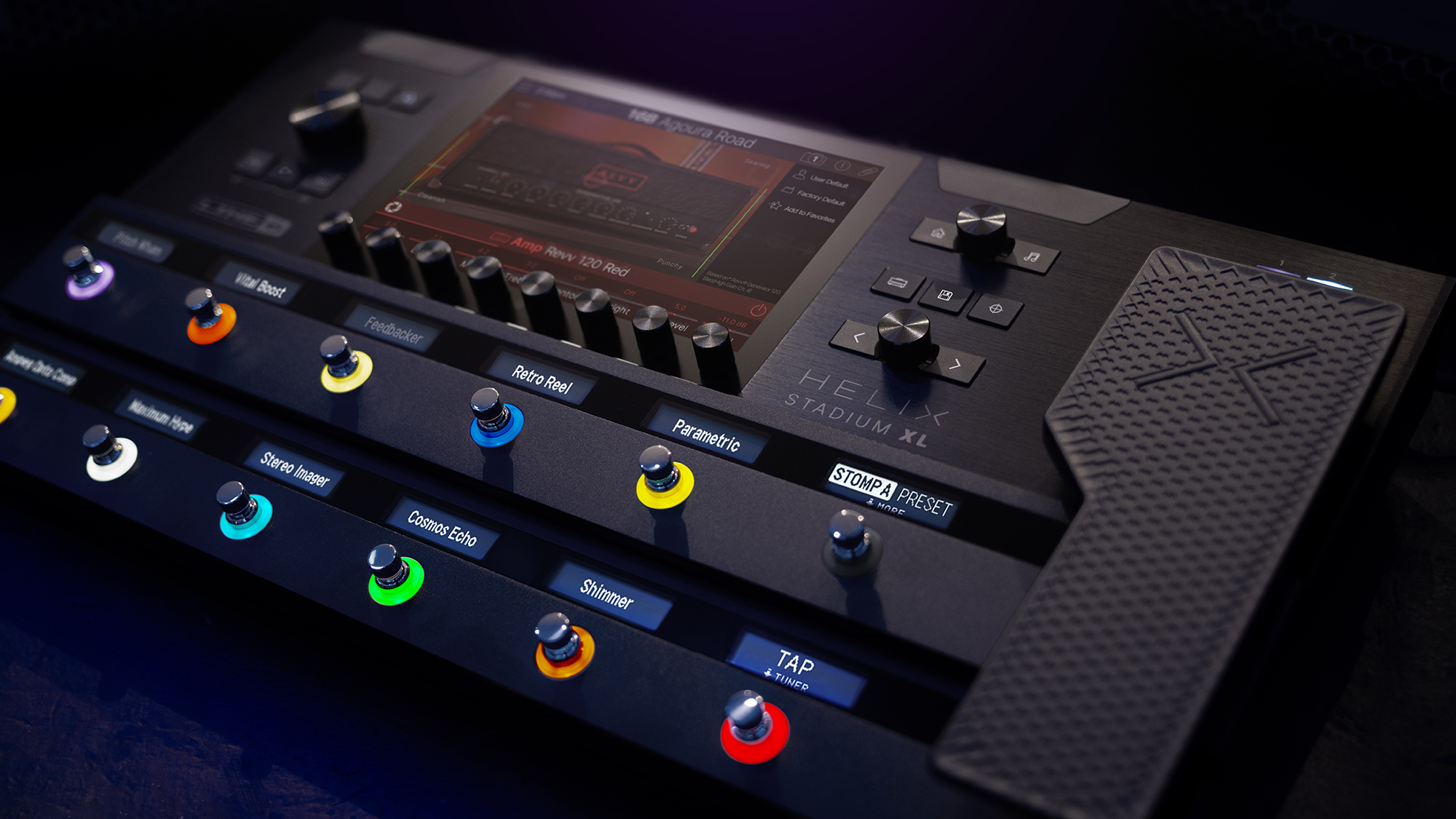The 50 greatest guitar solos of all time
The best lead playing ever committed to record, as voted by you
30. La Grange – ZZ Top (Guitarist: Billy Gibbons, 1973)
Billy Gibbons is credited as the first guitarist to record a pinched harmonic. There are tons of them here, ready to inspire the infant Zakk Wylde. Like Brian May’s sixpence, Gibbons’s Mexican peso guitar pick really makes the notes squeal.
The song changes key for the first solo, moving from A to C and feeling like things have kicked up a gear even before Gibbons brings the fire. Check out the doublestops just as the track fades out, too. There are two essential licks to get down from the first solo.
The first is from C minor pentatonic shape two: Gibbons slides into the G string fret 12, and alternates between this and B string fret 11 with hybrid pick and finger technique. Hear this lick for the first time at 1:41, and repeatedly thereafter. The second lick is the turnaround stops when the song moves back to A at 1:58.
Again using hybrid picking, Billy starts at fret 5 on the D string and high E string. The D string note moves down one fret at a time, but the E string stays on the 5th fret. It’ll also work over a 12‑bar blues in A.
29. Alive – Pearl Jam (Guitarist: Mike McCready, 1991)
Despite being one of grunge’s biggest acts, Pearl Jam have always been more of a classic rock band with a distinctly 90s aesthetic.
Underneath the plaid shirts and warbled vocals of Eddie Vedder, PJ were a stadium rock band hidden in plain sight. Case in point: Mike McCready’s solo in Ten highlight Alive is in fact a homage to Ace Frehley’s solo in Kiss’ 1975 track She – itself, in turn, copied from Robby Krieger’s solo in The Door’s Five To One.
The self-identified plagiarism (at best a compliment, at worst a lawsuit) doesn’t take away from its impact, though, as Alive’s laidback riffing and incendiary choruses are the perfect backdrop for McCready to display of all his favourite guitar hero techniques, such as vibrato, whammy bar bends and a heavy wah presence. The combination works tremendously, reaching euphoric heights in the song’s long outro.
All the latest guitar news, interviews, lessons, reviews, deals and more, direct to your inbox!
28. Firth Of Fifth – Genesis (Guitarist: Steve Hackett, 1973)

Steve Hackett: “Tony Banks wrote the song and there was a section on piano which was essentially the melody I play. I had the idea of touching on the lyrics, which talk about a river that becomes the sea. I imagined, with this held sustained feedback note, that the big keyboard swells were the sea and my part was a seagull flying high above.
“It all tied in with me getting new bits of equipment – I was using a Hiwatt amp, a Schaller volume pedal, a Tone Bender fuzz box and an Echoplex. The combination of all those things meant that I could produce my own sound – I could suddenly sound live, or so it seemed to me, and it felt like this big quantum leap forward.
The guitar I used was a 1957 Les Paul Standard with humbuckers. You could describe it as an original. I really love that guitar and I’ve still got it
“I worked around Tony’s melody and my amp just happened to feed back fairly reliably on a high F# note which suited the solo. I minimised some of the really pianistic bits which sounded quite Bach-like in favour of more elegiac and soaring moments. It was the longest solo I ever did for Genesis. I never timed it but it must be about three or three and a half minutes long. So there was the writer, the player and the interpretation...
“The guitar I used was a 1957 Les Paul Standard with humbuckers. You could describe it as an original. I really love that guitar and I’ve still got it. Having had several Les Pauls stolen over time, always at gigs, I no longer take it on the road with me. I just think that would be jinxed.
“I’m still in love with it and it’s still the guitar of my dreams. At the time I was using the bridge pickup pretty much exclusively but this solo sounds thicker than that. It may have been at [producer] John Burns’ suggestion, being a guitarist himself, that I used both pickups.
“At one point I was employing an EBow to play it live and that worked well for a while, except for having to pick it up and put it down, but these days I tend to play it on a Fernandes guitar with a Sustainer. It’s more reliable and less hit or miss, feeding back reliably nine times out of 10.
“There are some major 7th notes in there to give it that harmonic minor sound – it’s a very interesting scale. The whole middle-Eastern world opens up to you when start playing it, which is a great thing!
“For me, this was the closest thing to adagio rock guitar that can be done, with slow melodies. It’s not a million miles off what Erik Satie was doing as a turn of the century French impressionist and composer, as well as Ravel or Bach.
“Of course, guitarists weren’t the first to play harmonic minor – you get it in Rachmaninoff, Tchaikovsky – with Russian composers particularly, bordering those exotic regions with that vast landscape. You get it with the French, who were not immune to the pull of the East themselves! And it mixes with rock very well... Just ask any member of The Yardbirds or Led Zeppelin!”
27. Europa (Earth's Cry Heaven's Smile) – Santana (Guitarist: Carlos Santana, 1976)
Released in 1976, Santana’s Amigos album marked a return to commercial success for the band across Europe. Particularly remarkable was the chart success of Europa, not because Santana weren’t well-known, but because this is a five-minute instrumental. Take a listen and you might feel like you’ve heard the track before, and this is thanks to the use of a standard jazz chord progression.
Listen to Joseph Kosma’s Autumn Leaves and you’ll hear where Carlos found his inspiration. Following those trademark licks in the song’s first half, Europa takes you on a journey outside of that standard progression with a move to a simple I-IV progression in a minor key and some fiery playing.
26. Limelight – Rush (Guitarist: Alex Lifeson, 1981)
In 1996, Alex Lifeson related to Guitar World, “The approach on that solo was to try to make it as fluid as possible. There was a lot of bending with lots of long delay repeats and reverb, so notes falling off would overlap with notes coming up. I spent a fair amount of time on that to get the character, but once we locked in on the sound, it came easily.”
In fact, the most prominent “bending” came in the form of whammy bar divebombs played on Alex’ Floyd Rose-equipped Hentor Stratocaster through a Marshall Club And Country 50-watt combo. “We set up a couple of amps outside of the studio as well as inside,” Lifeson related, “so we got a nice long repeat with the echoing in the mountains.”
25. Something – The Beatles (Guitarist: George Harrison, 1969)
Following the sprawling White Album, George Harrison’s songwriting continued to mature into the Abbey Road sessions, culminating in one of the most stunning compositions of his career.
The symphonic ballad saw Harrison, for a moment at least, outdo fellow songwriters John Lennon and Paul McCartney, with Lennon himself referring to it as the best song on Abbey Road.
The simple piece is mostly in the key of C major, before moving to A major in the bridge. Having invited Eric Clapton to record the solo for While My Guitar Gently Weeps the previous year, Harrison resumed lead duties here, and the yearning, melodic playing is arguably his finest ever committed to tape.
25. Blackbird – Alter Bridge (Guitarists: Mark Tremonti, Myles Kennedy, 2007)

“That song is special in many ways,” said singer and guitarist Myles Kennedy of the title track from Alter Bridge’s second album, Blackbird.
It was an album that saw Myles contribute guitar to the band for the first time, and also work more closely as a writer with guitarist Mark Tremonti than before. “The way we were feeding off each other was like we were capturing lightning in a bottle,” Myles said. The positivity of this writing dynamic contrasts with the mood of the music.
Blackbird’s mournful atmosphere is set from the beginning by the fingerpicked verse part – two-finger technique that has Tremonti’s hallmark all over it. “I’d been throwing it around for a while and I really loved it,” Tremonti explained. “It had such a sad classical feel to it.”
I remember from the moment we realised what kind of a guitar player Myles was, we tried to really push that to the forefront and show his skill on the guitar, because I felt that it was a secret weapon
Mark Tremonti
Kennedy’s vocal and lyrics, and the subject matter they address, match the dark power of the music. “As we got to that point musically, I had a friend I’d known for a long time that was passing away,” Myles explains. “The lyrics came pretty quick because it was just capturing that moment. I wanted him to find his peace and he did. He passed away within days of completing it.”
The emotive heart of Blackbird is lifted by its solo section – an alliance of the pair’s distinct lead approaches that finds them realising the potential of the two-man solo in a way few rock players do in the post-Hotel California era. Mark was the instigator of taking on the challenge...
“I remember from the moment we realised what kind of a guitar player Myles was, we tried to really push that to the forefront and show his skill on the guitar, because I felt that it was a secret weapon,” he said. “For a band not to have a player of his calibre even touch a guitar on the first record, to come out blazing on the next record would really shock people – and give it that ‘wow’ factor.
“We felt it was a great moment for our two styles because he took the part where he could really follow the chord changes and throw his knowledge of his feel and phrasing into that; then my more aggressive lead style back to back with that. It was a good combination, one of those hairs-standing-up-on-your-arms moments.”
Myles’ 16-bar offering is pentatonic/blues scale-based and follows a simple ‘low and slow’ to ‘high and fast’ approach as he develops his melody lines. Clearly it’s the gentler of the two solos – Mark follows up with aggressive vibrato and rapid legato lines, before that super-fast picked lick that rounds off proceedings.
It’s the kind of lick that you don’t need to be too accurate with – Mark’s playing roughly six notes per beat, but he plays loosely here. Aim to get the fretting aspect tight, but just let rip with your pick hand.
23. Johnny B. Goode – Chuck Berry (1957)
Is there a more influential pioneer of guitar music than Chuck Berry? Probably not. And this song about an illiterate “country boy” with a gift for guitar playing is his best known.
Nerds still argue over the guitar he used. We know it to be either the humbucker-equipped Gibson ES-350T or the earlier P90 TN variant – both were used throughout his first stint on Chess Records. The 350T was introduced in 1957 – JBG’s year of release, hence the guesswork.
Either way, Chuck’s upbeat diads and bluesy phrasing set a template for generations of rock ’n’ roll acts that would follow. It’s fair to say that the Beatles, the Stones, AC/DC and countless others would likely sound somewhat different had they not been exposed to Chuck’s brand of rock ’n’ roll riffing.
If you plan to tackle Chuck’s solo, it’s based in the 6th position (in the key of Bb) and the diads fall broadly into two categories: shapes based at the 6th fret (easy because you can anchor your first finger in place), and shapes played at the 8th fret (a simple move of your third finger). Use downstrokes for the faster passages and a freer approach in the sparser sections.
22. Layla – Derek & The Dominos (Guitarist: Duane Allman, 1971)
The essential nugget of trivia here in Eric Clapton’s classic is that Duane Allman delivered the outro slide solo, not Eric himself. Donning his trademark 1957 Les Paul Goldtop and plugging into a Fender Champ, the slide specialist delivered his epic offering way up at the dusty end of the fretboard.
Some bemoan occasional off-pitch moments in Allman’s performance but take a look at the range he’s playing in and things become clear. Most of the solo is played above the 20th fret and a large portion is past the end of the fretboard – even as far as the (theoretical) 32nd fret.
Aside from the lack of any actual frets up there, those theoretical frets get closer together the higher you go. Was Duane staring attentively at his guitar, taking visual cues for position or was he playing purely by ear? We’ll never know.
But if we have one tip for playing beyond the fretboard, it’s to make visual/mental markers as to where those virtual frets are. Maybe a note will align with the edge of a neck pickup or a with a pickguard screw on your guitar. You can employ the same approach with harmonics.
21. Hanger 18 – Megadeth (Guitarist: Marty Friedman, 1990)
Megadeth have had no shortage of great lead guitarists over the years. It’s on the job description – if you want to play with Mustaine, you really have to be at the top of your game.
One of the reasons for this is because you will have to execute Marty Friedman’s leads for the live shows, and be good enough to do them justice. Hangar 18 could very well be the most impressive of them all, with no shortage of finger-twisting leads at blazing speeds.
His knack for twisting the wrong notes into the right ones – often bending from a fret or two underneath the one he’s aiming for – as well as employing more outside-sounding chromatic and diminished tonalities, is what gives a lot of his solos a unique and exotic quality.
20. Cliffs Of Dover – Eric Johnson (1990)
This instrumental won Eric Johnson a Grammy the following year for its exquisitely tasteful guitar playing and jaw-dropping tones. For the recordings, the Texan musician mainly stuck with his early 60s ES-335, though chose to use his 1964 ‘Virginia’ Strat for the opening lead and parts of the main solo.
The guitars were fed into a 100-Watt Marshall Super Lead, with an Echoplex and BK Butler Tube Driver used to help achieve those smooth, violin-like tones and warm sustain.
“I first heard him in 1986,” Joe Bonamassa told TG in 2015. “It was Cliffs Of Dover (Live At Austin City Limits), and it was just terrifyingly good guitar playing. I wasn’t even sure if it was real! Then I saw him live, and his tones were the best I’d ever heard. I wondered how this guy was getting all of these sounds out of his Strat. I’d never seen anybody have such a forward-thinking rig like that.”
Current page: The 50 greatest solos of all time: 30-21
Prev Page The 50 greatest solos of all time: 40-31 Next Page The 50 greatest solos of all time: 20-11Total Guitar is one of Europe's biggest guitar magazines. With lessons to suit players of all levels, TG's world-class tuition is friendly, accessible and jargon-free, whether you want to brush up on your technique or improve your music theory knowledge. We also talk to the biggest names in the world of guitar – from interviews with all-time greats like Brian May and Eddie Van Halen to our behind the scenes Rig Tour features, we get you up close with the guitarists that matter to you.

